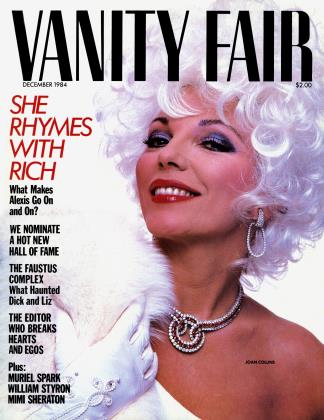Sign In to Your Account
Subscribers have complete access to the archive.
Sign In Not a Subscriber?Join NowSUITE DREAMS
Oh, give me a home where my butler may roam... The golden age of palace hotels, the subject of the newly published Grand Hotel (Vendome Press), is conjured up here by HUGH MONTGOMERY-MASSINGBERD
There’s something intoxicatingly theatrical about the old grand hotels, and what distinguishes them goes beyond the noble proportions of the architecture, the beauty of the decor, and the lavishness of the fittings to that elusive commodity—style.
The grand hotel emerged halfway through the nineteenth century but did not come into its own until two decades before the First World War. La Belle Epoque, that opulent and overblown period from the 1890s to 1914, marked the fusion of the old world with a rich new one. In a festival of frivolity, an interchangeable “society” drifted through grand hotels as the seasons changed in London, Paris, Cannes, Monte Carlo, Vienna, Marienbad, and Biarritz. And with the flowering of the grand hotel came the great transatlantic liner, ferrying in an American clientele. It was an age of aristocratic wits like Robert de Montesquiou and Boni de Castellane (who married the American railroad heiress Anna Gould), of les grandes horizontales like Liane de Pougy and La Belle Otero from the demimonde. By the turn of the century a new cosmopolitanism existed in Europe. Tout Paris was no longer confined to the French; the city’s grand hotels were filled with worldly Americans. And in Britain the ranks of the rich were swelled by families of foreign origin: American, South African, Greek, and German.
The decade of the Jazz Age, from the U.S. Congress’s passage of Prohibition in 1919 to Wall Street’s Black Thursday of 1929, was the next supreme moment for the grand hotel. It was truly the era of the American in Paris, and the new, Americanstyle bars established at the Ritz, the Crillon, and other grand hotels represented the period in all its raffish glory.
In Paris, Hollywood film stars flocked to the new Hotel George V, and in London the new Dorchester proved equally popular. After Charlie Chaplin was mobbed at the London Ritz in 1921, the hotel tended to keep actors at arm’s length, but the Savoy remained a haven for “show business” in all its guises, from Gilbert and Sullivan, Oscar Wilde, Lillie Langtry, and Nellie Melba to George Gershwin, Tallulah Bankhead, and Ivor Novello.
Every grand hotel had its own style, its own special ambience, but our fascination with these establishments has as much to do with the figures who frequented them as with their own architectural presence. The essayist Peregrine Worsthome spoke for many when he wrote of feeding at the London Ritz “not on oysters and champagne but on memories of a past world." And for the nostalgic, the grand hotel provides an irresistible feast of anecdotes. In Rome’s Grand Hotel, Emile Zola burrowed under the sheets during a thunderstorm; in Paris at the Ritz, Marcel Proust stood on the balcony in July 1917 to watch the Gotha air raid. And at the Hotel du Cap, in Antibes, Prince Apraxin bade his cossack servant eat the strawberries the Russian grandee had mashed up. “As a matter of fact," confessed the prince, “I can’t bear strawberries, but I do so adore the perfume they give off when they are crushed."
The bearded, portly figure of Edward VII, the Prince of Wales (or Lord Renfrew, as he sometimes described himself on his travels), was a familiar sight in hotels all over Europe during his mother’s long reign. Queen Victoria herself was not averse to leisurely visits to resorts in the Alps and on the Riviera, though she drew the line at Monte Carlo.
The center of Monaco was named after Charles III of the House of Grimaldi, who turned “a rock and an orangery’’ into the playground of Europe. The Hotel de Paris provided a decorous setting for many of Victoria’s less reputable relations cavorting between stints at the gambling tables. Grand Duke Michael, a grandson of Czar Nicholas I, was the uncrowned king of Cannes, where he laid the foundation stone for the casino and the Carlton Hotel. But the monarch most associated with the Carlton in later years was King Farouk of Egypt, for whom the hotel was in the habit of roasting a fowl every half-hour around the clock in case he was feeling peckish.
Of the London hotels, the comparatively sober Claridge’s proved most popular with Europe’s royal families. Earl Mountbatten of Burma, Queen Victoria’s great-grandson, felt that Claridge’s rather private, barless interior helped it outstrip the London Ritz as a “royal” hotel because “the Ritz was palatial and had that certain aura, and, after all, most royal families have quite enough of palaces, so they rather like the more ‘family’ atmosphere of Claridge’s.”
The London Ritz’s most colorful royal resident was King Zog of Albania, who arrived in 1940 with a formidable retinue of bodyguards. Some of the royal luggage seemed exceptionally heavy, and George, the Ritz’s hall porter, asked His Majesty if they contained anything of great value. “Yes,” said King Zog, “gold.”
Now, that’s style.
 View Full Issue
View Full Issue












Subscribers have complete access to the archive.
Sign In Not a Subscriber?Join Now